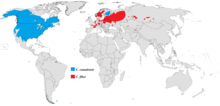Beaver
| Beaver Temporal range: Late Miocene – Recent
| |
|---|---|

| |
| North American beaver (Castor canadensis) | |
| Scientific classification | |
| Domain: | Eukaryota |
| Kingdom: | Animalia |
| Phylum: | Chordata |
| Class: | Mammalia |
| Order: | Rodentia |
| Family: | Castoridae |
| Subfamily: | Castorinae |
| Genus: | Castor Linnaeus, 1758 |
| Species | |
|
C. canadensis – North American beaver | |

| |
| Range of the living beavers as of 2016 (including introduced C. canadensis populations in Europe and Patagonia, but missing C. fiber populations in Mongolia and northwestern China, as well as reintroduced populations in the United Kingdom) | |
A beaver is large rodent. It is semi-aquatic: some of the time it lives in water, some of the time it lives on land. Beavers are only found in North America and Europe. In Great Britain, for example, they have been deliberately re-introduced. In Europe, they almost died off, but they are returning. There are beavers living in the Elbe and Rhone rivers, as well as in Bavaria, Poland and Scandinavia. Beavers are known for building and keeping dams in rivers.
Their dams slow down rivers and reduce erosion. The wetlands they create benefit many other species. Special arrangements are needed to let salmon and other migratory fish pass the dams to spawn.
Kinds of beavers
[change | change source]There are two different species of beaver, the American beaver (C. canadensis) and the European beaver (C. fiber).
The American beaver
[change | change source]This beaver is in North America, in Canada, the United States and in Northern Mexico. It is the second largest rodent in the world, and the largest found in North America. The largest rodent of the world is the capybara in South America.
The European beaver
[change | change source]The European beaver is currently an endangered species. It was hunted almost to extinction. This was done because of its fur, and because of castoreum. Castoreum is made by a gland, which is also responsible for the smell of the animal.[1] It is used as a tincture in some perfumes[2]
People are currently (2007) reintroducing the beaver, because the important role of the beaver for the ecology of rivers was discovered.[3] Beaver dams (or the small lakes that form) provide a habitat for many species.
Beaver fur
[change | change source]Early visitors that met Native Americans saw them wearing animal skin blankets. The fur on these blankets were good for felting. The Europeans wanted felt hats, and the Native Americans wanted metal: so, fur trading began.
Beaver was the most popular fur for hats. At that time in North America, there were about sixty million beavers. Only the soft inside fur was used for felting. The best time for collecting the beaver's fur was winter, when the fur was thickest. It was also a good time to hunt, since the beaver stayed close to its home in the winter and was easy to catch. The fur trade gave money to the European traders. The Indians who caught the beavers got the metal tools and other high technology items they wanted, until the beavers were mostly gone.
Images
[change | change source]-
An American Beaver
-
Beavers chopped down this tree
References
[change | change source]- ↑ Gippoliti (2002). Castor fiber. 2006 IUCN Red List of Threatened Species. IUCN 2006. Retrieved on May 11, 2006. Database entry includes justification for why this species is near threatened
- ↑ International Perfume Museum, Grasse, France, Website: "Welcome in the International Perfume Museum: Raw materials". Archived from the original on June 24, 2007. Retrieved February 28, 2006.
- ↑ "Europäischer Biber". WWF Österreich. Archived from the original on February 14, 2005. Retrieved August 24, 2006.
- MacDonald & Cook (2000). Castor canadensis. 2006 IUCN Red List of Threatened Species. IUCN 2006. Retrieved on May 12, 2006.
- "Castor canadensis". Integrated Taxonomic Information System. March 18, 2006.
Other websites
[change | change source]- Ecology of the Beaver Archived 2020-02-17 at the Wayback Machine
- Canadian Heritage - the beaver as a national symbol Archived 2007-04-30 at the Wayback Machine
- The romance of the beaver; being the history of the beaver in the western hemisphere, by A. Radclyffe Dugmore. Illustrated with photographs from life and drawings by the author. Publisher: Philadelphia, J.B. Lippincott company; London, W. Heinemann 1914 (a searchable facsimile at the University of Georgia Libraries)



